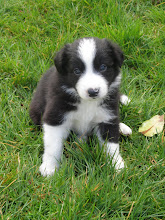Sharky’s Diary – Chapter Two
It has been suggested that a small section about me might be appropriate at this stage. I have been involved in agility since 1993. I have trained 8 dogs of my own and have attained the following titles with them - 6xADX, 3xADXGold, 5xFD, 3xCDX and 2 Agility Champions. I have participated in dog sports of agility, obedience, flygility, dancing with dogs, and a brief interlude with tracking. I have been on the agility judges panel since 2000, was Treasurer for Waikato Agility Group for a few of years, Deputy Zone One Representative for a couple of years, and NALA Treasurer/Membership Co-ordinator for far too many years (over 10 anyway).
My goal in starting this diary was to make people aware of some of the early training that you can do with pups. I am happy to answer questions about my training methods and possibly will be able to direct people to other trainers in their area. This diary is not supposed to be a comprehensive list of everything you can teach your pup with step by step instructions.
Anyway, enough about me and back to Sharky (Rainstar Shark Attack).
Next month I will explain how I intend to teach Sharky to do contact equipment. But, before you start thinking about this, it is very important that you have a few basic skills with your dog first.
1. Be able to play tug with your dog in any place at any time. So whenever you are in a different place, or there are different distractions make an effort to get out your toy and have a play.
2. Your dogs should understand how to wait, and know what their release command is.
3. It is very helpful if your dog is used to offering behaviours. To get your dog to offer behaviours, you need a clicker, food, and patience. There are many web-sites and books which explain how to train with a clicker, but the easiest way is to get someone you know to show you. Once your dog knows what the clicker is, the next step is to put out your object (footstool or whatever), and wait. When your dog does anything to interact with the object, click and treat. This could be looking at it, advancing towards it, touching it with nose, or foot etc. Once dog knows that you want it to do stuff with the object, they generally get quite carried away with offering different behaviours around it. The funniest one that Sharky had was when I put a bucket sideways on the ground. He thought what I wanted was for him to put his head in and scratch at the bottom of the bucket at the same time. Was hilarious to watch, and I did click him for it, but what I had originally wanted was just the head in the bucket. The reason I reinforced the behaviour was because it was so funny, and a good party trick.
As an example the photos following show a couple of different things that Sharky will do with a footstool (purchased for $9 from The Plastic Box).
The action in the first photo when he has got his front feet on top of the stool is a perfect position to start his rear end awareness work. Click when your dog’s feet are on the top of the stool. Once the dog is confident and happy to put his front feet on the perch, move on to pivoting your body slightly to encourage him to move his hind legs around. As soon as one leg moves, click and treat. Generally it doesn’t take long for the dog to realise that you want them to pivot their hind legs in both directions around the stool. The idea of this exercise is to be for your dog to know that it has rear legs, and to start to think of where to put them.
The action is the second photo is where he has his back feet on the stool – the 2 feet on the stool 2 feet off the stool (2o2o) contact behaviour that I eventually will want to teach. I like to reward this behaviour often, and wait until Sharky lowers his head before I click and treat. Eventually I will want to shape his head position as well as where he has his feet, and this is a good start. When you click and treat, you are clicking for the behaviour, and rewarding for position. So when you give your treat, make sure that you offer it down low if you are wanting to encourage a low head position. If you always treat your dog in the 2o2o position when his head is up, then he will assume that the position that you want is with his head up.
If you do not have good food and play drive, a reliable wait, and dog offering behaviours, then it is well worth while delaying any other training until you have achieved this. You will find that training a dog with this focus will take far less time, and be more enjoyable than a dog that doesn’t. You can teach all the other agility stuff later, but getting these basics right is extremely important.
Next month, those damn contacts!
Fiona Ferrar
Friday, May 30, 2008
Subscribe to:
Post Comments (Atom)



No comments:
Post a Comment